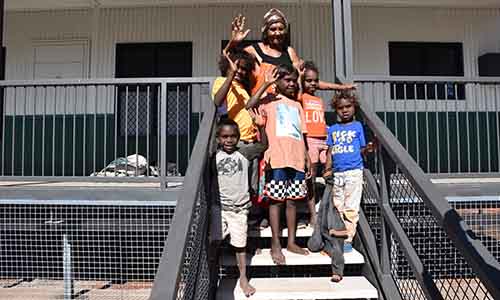The delivery and success of the remote housing program
When you’re hundreds of kilometres from the nearest major regional township, homelessness looks very different to other parts of the country.
For Pauline and her grandchildren who live in Kalkarindji, 464kms southwest of Katherine in the Northern Territory (NT), homelessness is less about no rail and bus terminals to sleep rough, homelessness is living in overcrowded conditions with parents raising children in one bedroom.
Remote communities are important to keeping Aboriginal people connected to community and Country and shouldn’t come at the expense of a life well-lived.
Tackling homelessness in remote Aboriginal communities is more than just finding housing, it’s about creating jobs and education opportunities.
Land belongs to Traditional Owners (TO) and is leased back by the NT Government who build homes for tenants to rent as public housing. The ‘Australian dream’ of owning a home out here isn’t a reality. Whether you win the lottery, earn royalties from TO leasing or work your arse off in a job, building and owning your own home isn’t an option.
There is a recognised, urgent need to develop sustainable housing solutions for remote Indigenous communities across the country, this is a core focus for the NT Government. Aboriginal people are considerably overrepresented in the homeless population, making up 23% of the homeless population within Australia and making up 87% of the homeless population in the NT. On Census night in 2021, there were 564 homeless people per 10,000 in the NT, significantly more than the national rate of 48 people per 10,000*. Investment into remote communities will work toward defeating these scary statistics and with a sustained effort in this space NT Government has made remarkable strides in enhancing remote housing and improving the lives of residents in these areas.
Despite the mammoth efforts, housing conditions and homelessness as a result of overcrowding continues to be a huge burden and a growing issue for our remote Indigenous communities. The Australian Government recently committed to extending the funding for remote housing to $4 billion over the next decade, recognising the continuing need for support in this space. This funding will enable the construction of up to 270 new homes annually, with a cumulative total of up to 2,700 new homes over 10 years.
The government commitment to remote housing is evident through the historic investment of $2.2 billion, the largest in the Territory's history delivered through the 'Our Communities. Our Futures. Our Homes.' program. This initiative has resulted in the construction of over 1,000 new and extended homes across remote communities thus far. Such developments have not only provided essential housing but also fostered a sense of community and stability among residents.
In Kalkarindji, one of the 73 communities to benefit from the housing works program, a substantial 111 additional bedrooms have been added. This has allowed families like Pauline Ryans' to move from severely overcrowded homes to more suitable living spaces. The community has seen the completion of 28 new builds and 11 home extensions. The positive impact is evident in the joy and relief on residents' faces as they receive the keys to their new and upgraded homes.
Joint Territory and federal funding for NT homelands has also been reinstated through the Homelands Housing and Infrastructure Program (HHIP). The program focuses on building and upgrading homes, enhancing essential services and supporting infrastructure projects. This collaborative financial arrangement shows commitment to providing culturally appropriate and durable housing solutions for the residents of homelands and demonstrates governments recognition of homelands as important cultural locations for Aboriginal people. Over the next 3 years an additional $40 million will be allocated by the Australian Government to continue the vital work of the Homelands Housing and Infrastructure Program.
A fundamental element in the NT Government’s approach to deploying housing works in remote communities and homelands is centred on community collaboration. By partnering closely with local communities, land councils and AHNT the government ensures that housing projects are culturally appropriate and tailored to the specific needs of each area. This method has improved housing conditions and empowered communities, fostering a sense of ownership and pride among residents. Whenever possible, Aboriginal-owned businesses are contracted for these projects, providing employment opportunities for community members.
Impressive results
The impact of the remote housing program is highlighted by its impressive results:
- Over 3,400 new bedrooms built and an additional 1,096 new living spaces constructed.
This monumental achievement addresses overcrowding and provides residents with safe, comfortable living spaces. - Significant investment in homelands of $100 million.
The reintroduction of federal funding facilitated the rapid establishment of essential infrastructure in NT homelands. - Community engagement enhanced through over 800 local decision-making consultations.
The program’s emphasis on local decision-making and collaboration with Aboriginal community-controlled organisations has strengthened community ties and ensured culturally sensitive project delivery. - Enhanced living conditions.
Numerous remote communities now benefit from upgraded housing and improved living standards, fostering healthier and more stable communities overall. - Economic boost including 45.3% of works conducted by Aboriginal owned enterprises.
The program has created job opportunities within remote communities, contributing to local economies and empowering residents.
The success of the remote housing program in the NT is a testament to the government's dedication to improving the lives of its residents. Through continued strategic investments, community collaboration, and adaptive strategies the NT Government has set a benchmark in delivering effective and sustainable housing solutions in remote areas. As the program progresses, it promises to continue driving positive change and enhancing the well-being of communities across the Northern Territory.
* Data from the ABS website.

